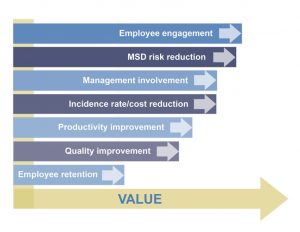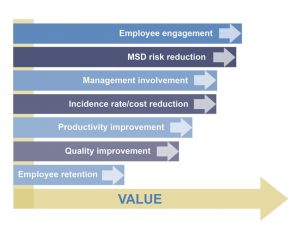The Secret of Employee Engagement: Ergonomics
01/17/2018

Recently, Humantech surveyed its users of The Humantech System®, an ergonomics  management tool for production and manufacturing environments, to identify the trends and benefits of their ergonomics process. Participants were asked to select and rank the value(s) their company had derived from their process. To our surprise, employee engagement ranked first, over values like reduced level of exposure to MSD risk, improved management involvement and accountability, and reduced MSD incidence and cost.
management tool for production and manufacturing environments, to identify the trends and benefits of their ergonomics process. Participants were asked to select and rank the value(s) their company had derived from their process. To our surprise, employee engagement ranked first, over values like reduced level of exposure to MSD risk, improved management involvement and accountability, and reduced MSD incidence and cost.
Over the past decade, employee engagement programs have been gaining traction, even among smaller organizations, due to the many research findings touting the positive link between the programs and human capital and financial performance outcomes. The Society for Human Resource Management cites the connection in the paper, “SHRM Research Overview: Employee Engagement.” So, how can we, as safety professionals, integrate these programs into an ergonomics process?
- Maintaining relationships at work is highly related to employee engagement. Initiating a participatory ergonomics program is one way to encourage teamwork and relationship building. Workers (with first-hand experience in ergonomics issues) from various departments and position levels, as well as stakeholders affected by the ergonomics intervention, are brought together in the problem-solving and decision-making process.
- Providing opportunities to use skills and abilities ranks high on the list of strategies organizations use to engage employees. Implementing an ergonomics training process not only builds skills and abilities, but it empowers and enables participants to identify, quantify, and prioritize musculoskeletal disorder risk, and apply ergonomics principles and design guidelines to improve human performance, enhance product quality, and increase manufacturing productivity.
Fact: organizations that sustain a solid ergonomics process have far fewer injuries and illnesses than their counterparts. Fact: those same organizations have less employee turnover, greater productivity, and a healthier profile overall. The goal of ergonomics is to optimize human performance. When ergonomics is done right, there are two primary positive outcomes: improved employee well-being and improved business performance. For more, read our position statement, “Value Proposition of Ergonomics.”
The bottom line: when people know they are cared for and that their job responsibilities and expectations aren’t outside their physical capabilities, good things happen.






